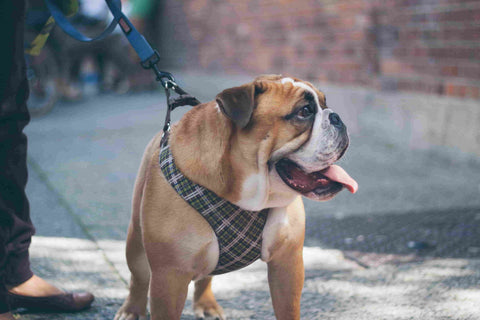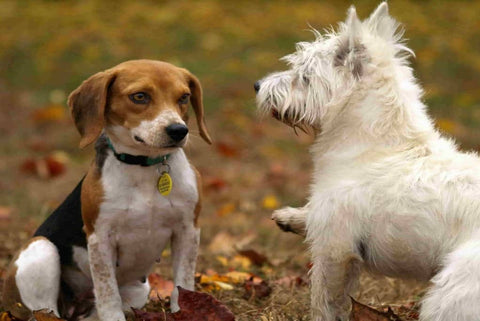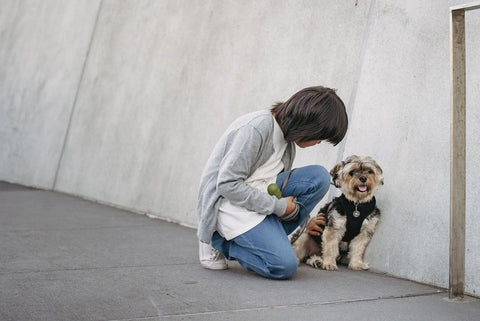How to Pick the Right Dog Training Harness
Dog-moms and -dads around the world know just how important it is to train your pup well. Dogs are intelligent, capable, and eager to please, making training a natural part of pet ownership. In addition, thorough training is a great way to boost your dog's health, improve his obedience to commands, and really develop the relationship you have with your dog.
To get the most out of your training sessions, you'll need the correct dog training harness that will provide security and comfort for your four-legged friend. Here's everything you need to know about getting the right training harness for your dog.
Step One: Get the Proper Size
Before you purchase any wearable dog accessory, you need to know the measurements that you're working with. An ill-fitting training harness can quickly become a safety hazard for both you and your pet. To get the right size, here are the measurements you need to take:
- Neck. Measure the circumference of your dog's neck by placing a flexible tape measure at the base of the neck.
- Chest. Measure around your dog's body an inch or so in front of the rear legs.
- Length. For this measurement, take your measuring tape and measure your dog's back, from just behind the front legs to where the tail meets the body.
Once you have your measurements, take a look at our dog harness size chart and choose the harness that fits your dog's measurements.
Step Two: Achieve the Perfect Fit
It goes without saying that no two dogs are exactly alike, and that goes for sizing, too. The good thing is that a great dog training harness will be adjustable to get the perfect fit. Here are a couple of tips to make sure that your four-legged friend is snug and secure.
- Tip 1: If your dog is just between sizes, or one of his measurements doesn't match up with the others, go for the larger size. To ensure your dog's safety, harnesses need to be purchased according to the measurements (even if Spot is usually a size large in other wearables).
- Tip 2: To ensure that you've adjusted the harness correctly, slip two fingers underneath all the straps. If it's a challenge, loosen the strap. Next, try to pull the harness up and over your dog's head. If you can, you need to tighten straps.
Don't forget – a dog training harness that doesn't fit properly could pose a serious risk to both you and your dog.
Step Three: Look for Several Important Features
Getting the right size harness is crucial, and once you know how to do that, you can move on to the features the harnesses have. When looking at different dog training harnesses, always prioritize comfort and safety.
Here are a few must-haves for a good training harness:
- The material should be breathable, soft, and durable. This will optimize safe and comfortable training.
- The harness as a whole should be lightweight. A heavy harness could tire your dog out too quickly and restrict the dog's movements, which isn't good for training.
- There should be several points of adjustment on the harness. Make sure that you have adjusted to the proper fit. If the harness doesn't adjust, it's probably not the right harness.
- Multiple clip locations give you more options for leash attachment. Your dog may respond better during training when the leash is connected in another way.
When choosing a harness, the above items should be non-negotiable. There are other features, however, that you should also look out for:
- Reflective straps will offer an extra layer of safety for you and your dog. This is especially important if you take late-night strolls or early morning runs with your dog.
- A good training harness should be easy to use. If it takes ten minutes of fumbling with straps and clips to get it on your dog, you won't be keen to use it every time and might be tempted to just use a collar – more on why that's a bad idea later.
- The harness should be comfortable for your dog to wear. Check out the two main models of harness – vest and strap – to see which one fits your dog's strength/size, training plan, fur length, etc. Vest harnesses are usually preferred to strap harnesses since they provide better security and won't irritate or chafe your dog's skin.
- A harness training set will include a retractable leash, so if you plan to incorporate that type of training, you might want to consider this set.
Questions About Training Harnesses for Dogs
Still have questions about dog training harnesses? Keep reading for answers to some of the most commonly asked questions from dog-owners like you.
Is it better to train a dog with a collar or harness?
It can be tempting to just leash up your dog with his daily collar for a quick potty break. However, if you're still in the process of training your pup, you'll definitely want to take the time to get that harness on. Even light pulling can cause pain or pressure to the dog's neck, so a collar could do more harm than good. If convenience is an issue, look for a harness with a retractable leash.
How do you stop a dog from pulling on a lead?
No-pull harnesses are created specifically to address this problem. They feature a leash clip at the front. When clipped this way, the leash will squeeze and lift the dog's shoulders if they start to pull. This doesn't hurt the dog, but it will deter him from pulling. It's an incredibly effective tool for teaching your dog to walk correctly in a safe and comfortable way for both of you.
At what age can you leash train a puppy?
Veterinarians typically recommend that you begin leash training when a puppy reaches ten months. By then, the puppy's body will be strong enough to support a properly fitted wearable pet accessory (like a training harness) without any harm to its health. To make harness training easier, train your puppy in other ways until then. For example, teaching simple commands like "sit," "lie down," and "stay" will prepare your dog for more challenging tasks.
How do you train your dog to wear a harness?
The key to training your dog to wear the harness in the first place is to not overwhelm him. Start slow: let your dog sniff the harness before putting it on him. Then, put the harness on him carefully for 30-60 seconds. Reward your pup with a training treat once he is calmly in the harness. Next, try leaving the harness on for incrementally longer periods. As you leave it on for more time, get your dog used to being active while wearing it – play with a favorite toy or training game so your dog can adjust to the feeling of wearing a harness and moving around in it.
Get the Best Training Harness From Pet&Cuddle!
If you're ready to get started on your dog training journey, a dog training harness is in your future! When you're searching for just the right one, look for a comfortable, functional, and secure option that fits your dog perfectly.
The in-house experts at Pet&Cuddle create premium dog products for any sports activity you do with your dog, like walking, running, hiking, and training. And now that you know just what to look for in a great new training harness, we're confident you'll find exactly what you need in our shop.
At Pet&Cuddle, we're dog lovers – just like you. With our deep knowledge and practical experiences as dog specialists, we've designed the perfect harness for your dog. Our unique models are comfortable, safe, and ready to go on any training adventure you have planned with your furry friend.
Ready to see what we mean? Check out our training harnesses for dogs!



